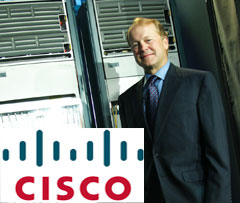 We had been waiting for Cisco to “Change the Internet Forever”, and seems like they almost did. Cisco has launched CRS-3 Carrier Routing System, is three times faster than its predecessor CRS-1, six years later.
We had been waiting for Cisco to “Change the Internet Forever”, and seems like they almost did. Cisco has launched CRS-3 Carrier Routing System, is three times faster than its predecessor CRS-1, six years later.
CRS-3 is designed to serve as the foundation of the next-generation Internet and set the pace for the astonishing growth of video transmission, mobile devices and new online services through this decade and beyond.
With more than 12 times the traffic capacity of the nearest competing system (Juniper), the Cisco CRS-3 is designed to transform the broadband communication and entertainment industry by accelerating the delivery of compelling new experiences for consumers, new revenue opportunities for service providers, and new ways to collaborate in the workplace.
On one side Google wants to experiment Gigabit Internet service, on the Other, Cisco would enable much more powerful systems.
Cisco’s CEO John Chambers highlights the basic facts of the new platform:
- The Cisco CRS-3 triples the capacity of its predecessor, the Cisco CRS-1 Carrier Routing System, with up to 322 Terabits per second, which enables the entire printed collection of the Library of Congress to be downloaded in just over one second; every man, woman and child in China to make a video call, simultaneously; and every motion picture ever created to be streamed in less than four minutes.
- The Cisco CRS-3 enables unified service delivery of Internet and cloud services with service intelligence spanning service provider Internet Protocol Next-Generation Networks (IP NGNs) and data center. The Cisco CRS-3 also provides unprecedented savings with investment protection for the nearly 5,000 Cisco CRS-1 deployed worldwide. Cisco’s cumulative investment in the Cisco CRS family is $1.6 billion, further underscoring the company’s commitment.
- AT&T, one of the world’s largest telecommunications companies, recently tested the Cisco CRS-3 in a successful completion of the world’s first field trial of 100-Gigabit backbone network technology, which took place in AT&T’s live network between New Orleans and Miami. The trial advances AT&T’s development of the next generation of backbone network technology that will support the network requirements for the growing number of advanced services offered by AT&T to consumer and business customers, both fixed and mobile.
- The Cisco CRS-3 is currently in field trials, and its pricing starts at $90,000 U.S.
We write about Networking, Google , Open Source, Programming, iPhone, Android and latest in Tech @taranfx on Twitter or by subscribing below:
loading...
loading...

You said “Cisco has launched CRS-3 Carrier Routing System, is three times faster than its predecessor CRS-2, six years later.”
and
“The Cisco CRS-3 triples the capacity of its predecessor, the Cisco CRS-1 Carrier Routing System,”
So which is the predecessor that the CRS-3 is three times faster than? CRS-1 or CRS-2?
loading...
loading...
uhh that's a typo. Cisco never released CRS-2 to public. It was supposed to be CRS-1. My bad
loading...
loading...